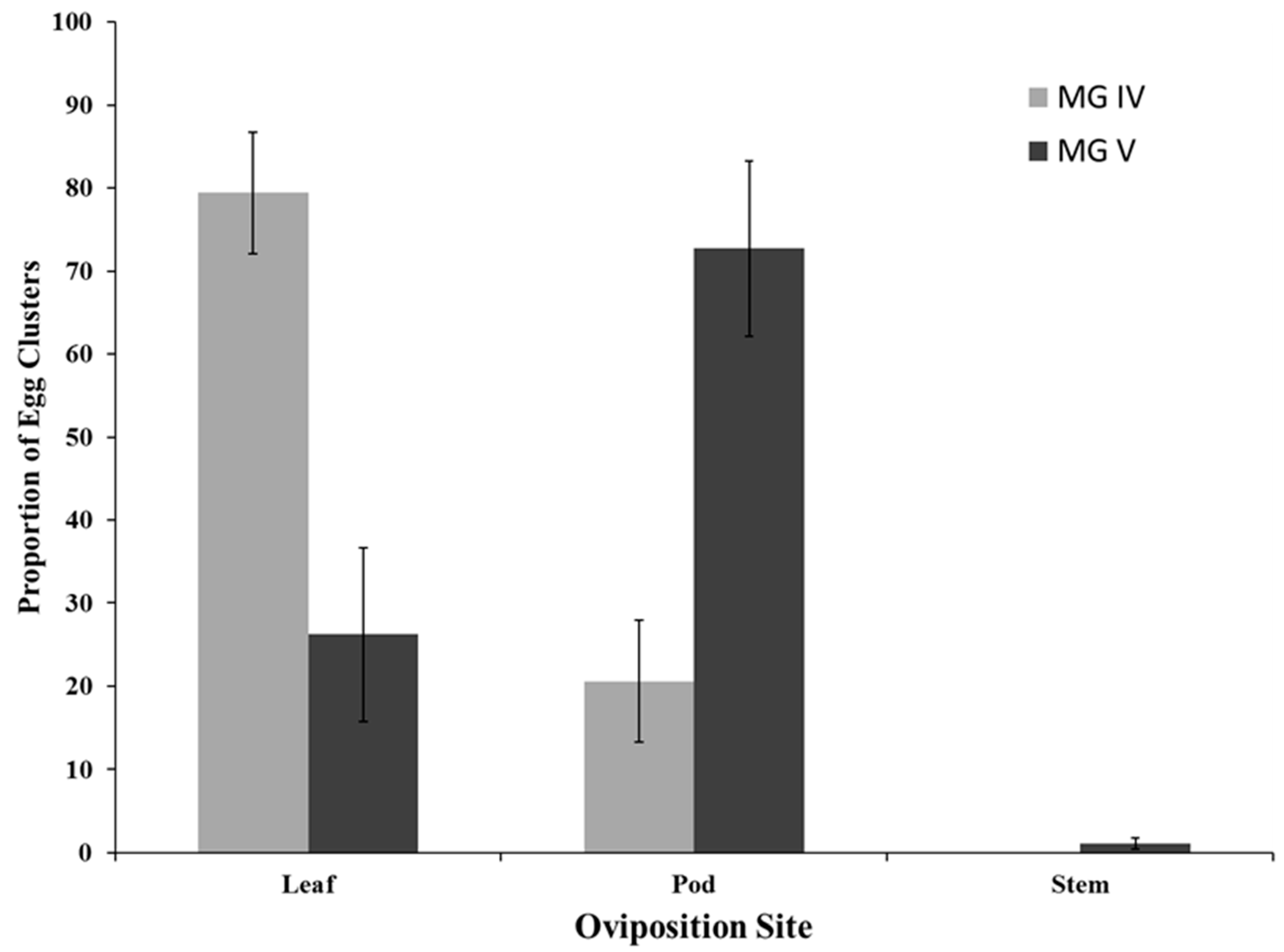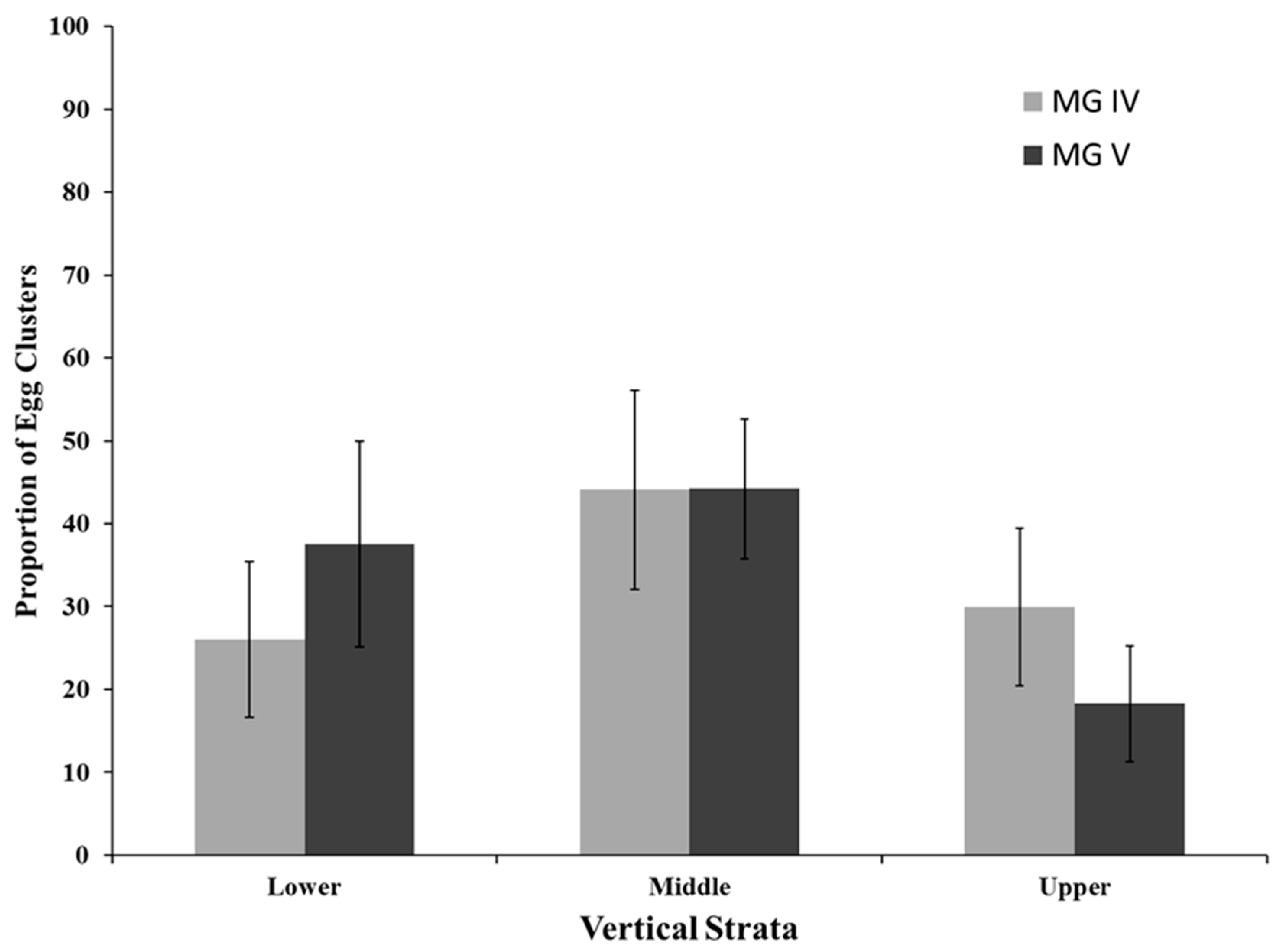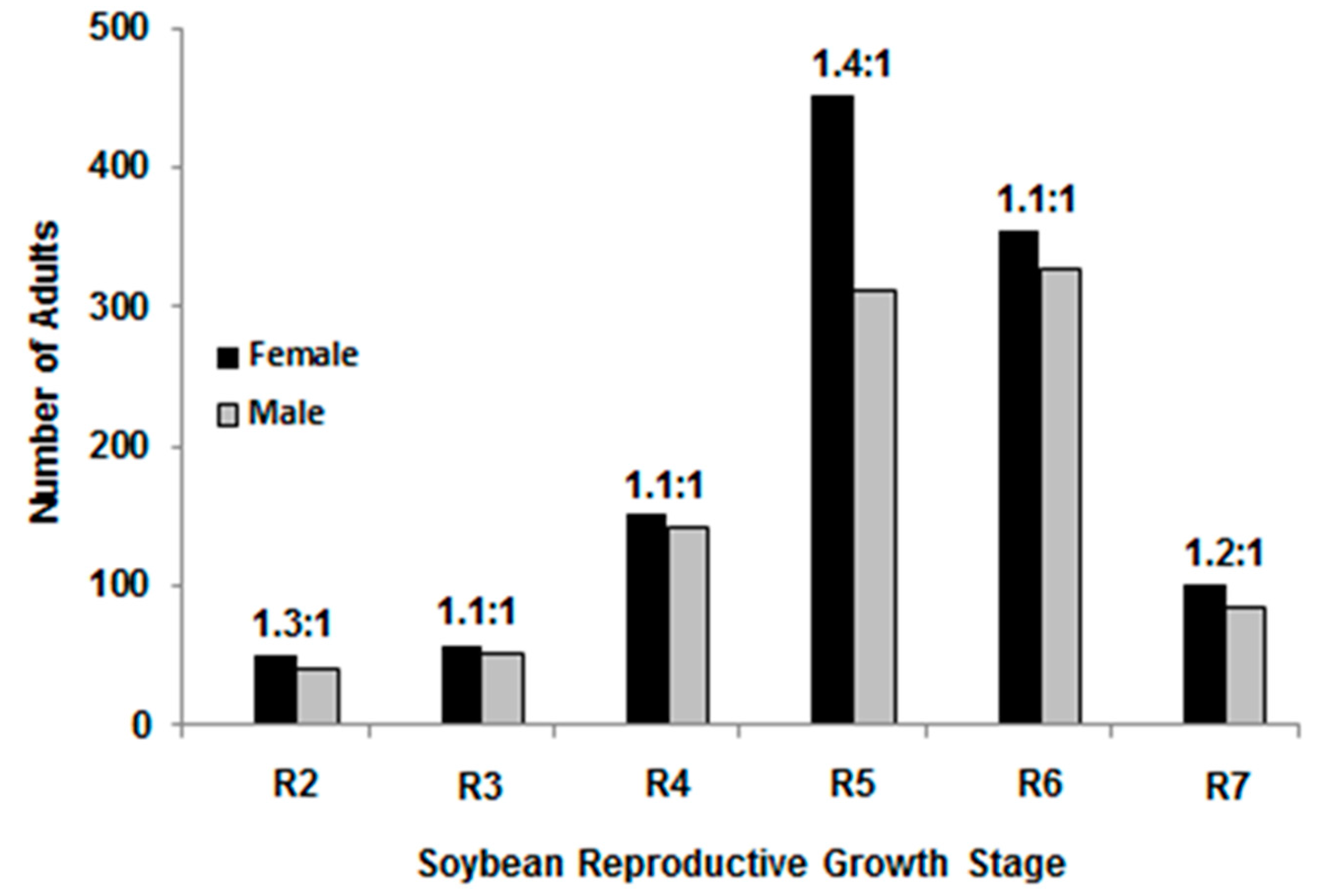Oviposition and Sex Ratio of the Redbanded Stink Bug, Piezodorous guildinii, in Soybean
Abstract
:1. Introduction
2. Materials and Methods
2.1. Oviposition Surveys
2.2. Adult Sex Ratio
2.3. Data Analysis
3. Results
3.1. Oviposition Surveys
3.2. Adult Sex Ratio
4. Discussion
5. Conclusions
Acknowledgments
Author Contributions
Conflicts of Interest
Abbreviations
| MG | Maturity Group |
| ANOVA | Analysis of Variance |
| HSD | Honest Significant Difference |
References
- Temple, J.H.; Davis, J.A.; Micinski, S.; Hardke, J.T.; Price, P.; Leonard, B.R. Species composition and seasonal abundance of stink bugs (Hemiptera: Pentatomidae) in Louisiana soybean. Environ. Entmol. 2013, 42, 648–657. [Google Scholar] [CrossRef] [PubMed]
- Panizzi, A.R.; Slansky, F., Jr. Review of phytophagous pentatomids (Hemiptera: Pentatomidae) associated with soybean in the Americas. Fla. Entomol. 1985, 68, 184–214. [Google Scholar] [CrossRef]
- McPherson, J.E.; McPherson, R.M. Stink Bugs of Economic Importance in America North of Mexico; CRC Press: Boca Raton, FL, USA, 2000. [Google Scholar]
- McPherson, R.M.; Douce, G.K.; Hudson, R.D. Annual variation in stink bug (Heteroptera: Pentatomidae) seasonal abundance and species composition in Georgia soybeans and its impact on yield and quality. J. Entomol. Sci. 1993, 28, 61–72. [Google Scholar]
- Panizzi, A.R.; McPherson, J.E.; James, D.G.; Javahery, M.; McPherson, R.M. Stink bugs (Pentatomidae). In Heteroptera of Economic Importance; Schaefer, C.W., Panizzi, A.R., Eds.; CRC Press: Boca Raton, FL, USA, 2000; pp. 421–474. [Google Scholar]
- Panizzi, A.R.; Smith, J.G. Biology of Piezodorus guildinii: Oviposition, development time, adult sex-ratio, and longevity. Ann. Entomol. Soc. Am. 1977, 70, 35–39. [Google Scholar] [CrossRef]
- Link, D.; Concatto, L.C. Hábitos de postura de Piezodorus guildinii em soja. Rev. Cen. Cien. Rur. 1979, 9, 61–72. (In Portuguese) [Google Scholar]
- Silva, M.T.; Ruedell, J. Local de oviposicao parasitismo e razao sexual de Piezodorus guildinii (Westwood, 1837) em soja. Trigo E Soja 1983, 65, 11–14. (In Portuguese) [Google Scholar]
- Baur, M.E.; Sosa-Gomez, D.R.; Ottea, J.; Leonard, B.R.; Corso, I.C.; Da Silva, J.J.; Temple, J.; Boethel, D.J. Susceptibility to insecticides used for control of Piezodorus guildinii (Heteroptera: Pentatomidae) in the United States and Brazil. J. Econ. Entomol. 2010, 103, 869–876. [Google Scholar] [CrossRef] [PubMed]
- Temple, J.H.; Davis, J.A.; Hardke, J.; Moore, J.; Leonard, B.R. Susceptibility of southern green stink bug and redbanded stink bug to insecticides in soybean field experiments and laboratory bioassays. Southwestern Entomol. 2013, 38, 393–406. [Google Scholar] [CrossRef]
- Levy, R.; Padgett, P.; Lofton, J.; Price, T.; Harrell, D.; Steven, J.; Stephenson, D.; Viator, S.; Haggard, B.; Bollich, P.; et al. 2015 Soybean Variety Yields and Production Practices; LSU AgCenter: Baton Rouge, LA, USA, 2015. [Google Scholar]
- Fehr, W.R.; Caviness, C.E.; Burmood, D.T.; Pennington, J.S. Stage of development descriptions for soybean, Glycine max (L.) Merrill. Crop Sci. 1971, 11, 929–931. [Google Scholar] [CrossRef]
- SAS Institute. SAS Version 9.4 for Windows user Guide; SAS Institue: Cary, NC, USA, 2015. [Google Scholar]
- Fraga, C.P.; Ochoa, L.H. Aspectos morfologicos y bioecologicos de Piezodorus guildinii (West.) (Hem. Pent.). Idia Supple. 1972, 28, 103–117. (In Spanish) [Google Scholar]
- Jones, T.H. The southern green plant-bug. U.S. Dep. Agric. Bull. 1918, 689, 1–27. [Google Scholar]
- Passlow, T.; Waite, G.K. Green vegetable bug as a soybean pest. Queens. Agr. J. 1971, 97, 491–493. [Google Scholar]
- Panizzi, A.R. Nutritional ecology of plant feeding arthropods and IPM. In Perspectives in Ecological Theory and Integrated Pest Management; Kogan, M., Jepson, P., Eds.; Cambridge University Press: Cambridge, UK, 2007; pp. 170–222. [Google Scholar]
- Link, D.; Panichi, J.A.V.; Concatto, L. Oviposigao de Piezodorus guildinii (Westwood, 1837) sobre feijoeiro. Rev. Cen. Cien. Rur. 1980, 10, 271–276. (In Portuguese) [Google Scholar]
- Link, D. Entomofauna da lentilha. I—percevejos Pentatomidae (Hemiptera). Rev. Cen. Ciên. Rur. 1979, 9, 379–385. (In Portuguese) [Google Scholar]
- Esselbaugh, C.O. A study of eggs of the Pentatomidae (Hemiptera). Ann. Entomol. Soc. Amer. 1946, 39, 667–691. [Google Scholar] [CrossRef]
- Deitz, L.L.; Van Duyn, J.W.; Bradley, J.R., Jr.; Rabb, R.L.; Brooks, W.M.; Stinner, R.E. A Guide to the Identification and Biology of Soybean Arthropods in North Carolina; North Carolina Agriculture Research Service: Raleigh, NC, USA, 1976; pp. 1–264. [Google Scholar]
- Todd, J.W.; Herzog, D.C. Sampling phytophagous Pentatomidae on soybean. In Sampling Methods in Soybean Entomology; Kogan, M., Herzog, D.C., Eds.; Springer-Verlag: New York, NY, USA, 1980; pp. 438–478. [Google Scholar]
- Kogan, M.; Pitre, H.N., Jr. General sampling methods for above ground populations of soybean arthropods. In Sampling Methods in Soybean Entomology; Kogan, M., Herzog, D.C., Eds.; Springer-Verlag: New York, NY, USA, 1980; pp. 30–60. [Google Scholar]
- Russin, J.S.; Layton, M.B.; Orr, D.B.; Boethel, D.J. Within-plant distribution of, and partial compensation for, stink bug (Heteroptera: Pentatomidae) damage to soybeans seeds. J. Econ. Entomol. 1987, 80, 215–220. [Google Scholar] [CrossRef]
- Hutchins, S.N.; Pitre, H.N. Effects of soybean row spacing on spray deposition and efficacy of insecticides applied with aerial and ground equipment. Environ. Entomol. 1984, 13, 948–953. [Google Scholar] [CrossRef]
- Barbosa, R.N.; Griffin, J.L.; Hollier, C.A. Effect of spray rate and method of application in spray deposition. Appl. Engineer. Agric. 2009, 25, 181–184. [Google Scholar] [CrossRef]
- Maziero, H.; Guedes, J.V.C.; Farias, J.R.; Rodriques, R.B.; Dalazen, G.; Pra, E.D. Different spray volumes and insecticides in the control of Piezodorus guildinii (Westwood) in soybean crop. Ciencia Rural 2009, 39, 1307–1312. [Google Scholar] [CrossRef]
- Heatherly, L.G. Early soybean production system. In Soybean Production in the Midsouth; Heatherly, L.G., Hodges, H.F., Eds.; CRC Press: Boca Raton, FL, USA, 1999; pp. 103–118. [Google Scholar]
- Baur, M.E.; Boethel, D.J.; Boyd, M.L.; Bowers, G.R.; Way, M.O.; Heatherly, L.G.; Rabb, J.; Ashlock, L. Arthropod populations in early soybean production systems in the Mid-South. Environ. Entomol. 2000, 29, 312–328. [Google Scholar] [CrossRef]



| Growth Stage | Plant Height (cm) ± SE | No. of Nodes ± SE | ||
|---|---|---|---|---|
| MG IV | MG V | MG IV | MG V | |
| R2 | 46.2 ± 0.7 d | 70.6 ± 0.8 e | 9.1 ± 0.1 d | 10.6 ± 0.1 d |
| R3 | 66.0 ± 1.1 c | 91.7 ± 1.0 d | 11.4 ± 0.2 c | 12.0 ± 0.2 c |
| R4 | 81.2 ± 1.6 b | 94.7 ± 0.9 cd | 13.7 ± 0.2 b | 12.4 ± 0.1 bc |
| R5 | 86.6 ± 0.8 a | 97.3 ± 0.7 bc | 14.7 ± 0.1 a | 12.9 ± 0.1 b |
| R6 | 89.2 ± 0.9 a | 99.7 ± 0.6 b | 14.8 ± 0.1 a | 12.7 ± 0.2 b |
| R7 | 87.9 ± 1.1 a | 105.1 ± 1.0 a | 14.5 ± 0.1 a | 14.2 ± 0.2 a |
| Growth Stage | Mean % Egg Clusters ± SE | |
|---|---|---|
| MG IV | MG V | |
| R2 | 10.0 ± 9.0 bc | 1.9 ± 1.2 b |
| R3 | 1.0 ± 0.6 c | 2.8 ± 1.3 b |
| R4 | 6.0 ± 3.7 bc | 5.6 ± 3.1 ab |
| R5 | 45.0 ± 12.0 a | 44.0 ± 14.4 a |
| R6 | 23.7 ± 9.3 ab | 41.7 ± 16.9 ab |
| R7 | 14.3 ± 9.0 b | 4.0 ± 2.0 ab |
© 2016 by the authors; licensee MDPI, Basel, Switzerland. This article is an open access article distributed under the terms and conditions of the Creative Commons Attribution (CC-BY) license (http://creativecommons.org/licenses/by/4.0/).
Share and Cite
Temple, J.H.; Davis, J.A.; Hardke, J.T.; Price, P.P.; Leonard, B.R. Oviposition and Sex Ratio of the Redbanded Stink Bug, Piezodorous guildinii, in Soybean. Insects 2016, 7, 27. https://doi.org/10.3390/insects7020027
Temple JH, Davis JA, Hardke JT, Price PP, Leonard BR. Oviposition and Sex Ratio of the Redbanded Stink Bug, Piezodorous guildinii, in Soybean. Insects. 2016; 7(2):27. https://doi.org/10.3390/insects7020027
Chicago/Turabian StyleTemple, Joshua H., Jeffrey A. Davis, Jarrod T. Hardke, Paul P. Price, and B. Rogers Leonard. 2016. "Oviposition and Sex Ratio of the Redbanded Stink Bug, Piezodorous guildinii, in Soybean" Insects 7, no. 2: 27. https://doi.org/10.3390/insects7020027





